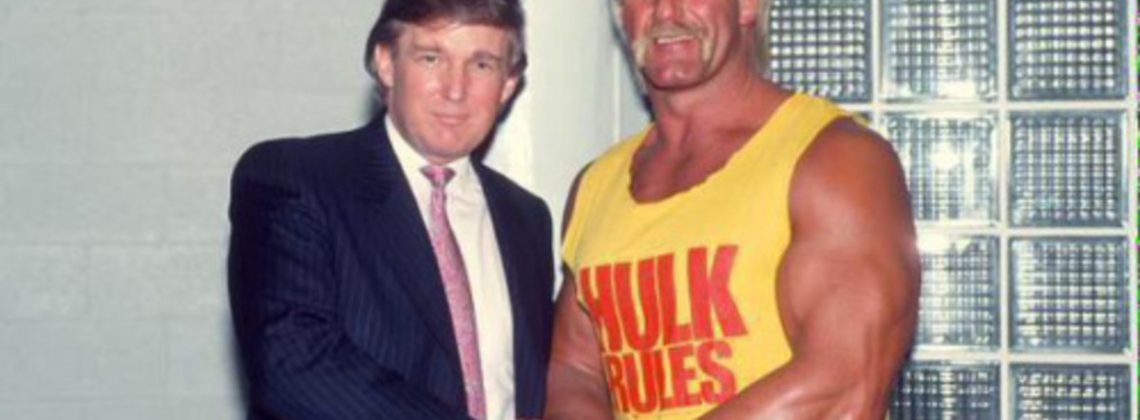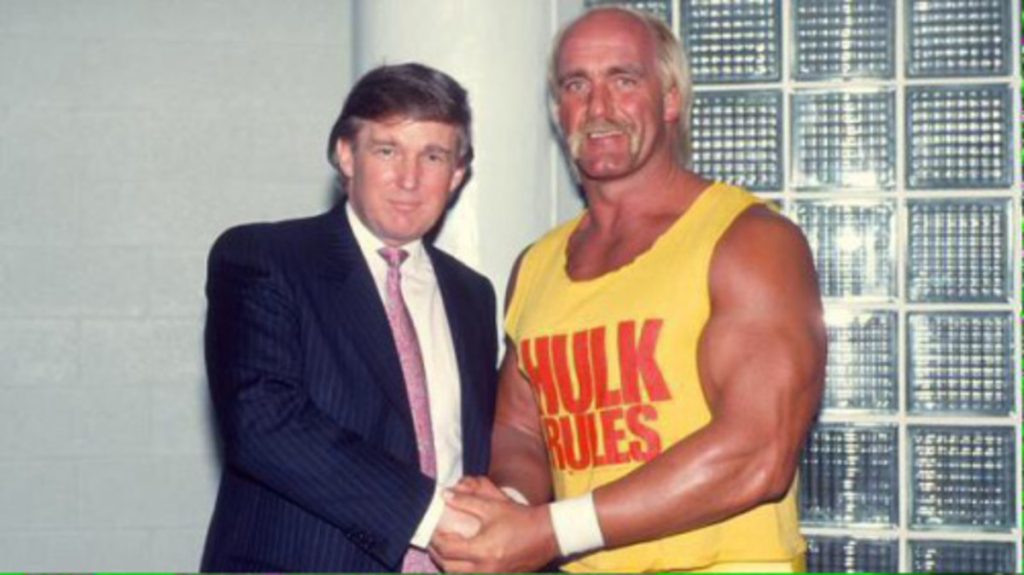

Maybe when Trump says “Make America Great Again” he has the 1980s in mind.
Here is a taste of Michael Grasso’s Jacobin piece, “Donald Trump and the ’80s Aesthetic“:
When Terry “Hulk Hogan” Bollea stood onstage at the Republican National Convention and ripped open his shirt, revealing a red Trump/Vance 2024 tank top underneath, he was reenacting a public victory ritual familiar to all Americans of the 1980s. Yes, Hogan was dutifully pledging loyalty to Donald Trump, but he was also reinforcing the aura of his own 1980s brand, linking their lives and careers in a shared retrospective vision of a golden era.
This gesture was only the latest of many similar devotional moments to Trump’s lifelong “success story,” a story that begins in the gilded lobby of his biggest project of the 1980s: Trump Tower. For both Trump and his most slavish supporters, it is permanently 1985. In this shared fantasy, the New York tabloid press is still there, reporting dutifully on Trump’s latest big deal, perhaps leaked to them by “John Barron” or one of Trump’s other confidential press aliases. The paparazzi and syndicated entertainment shows are capturing his image every night as he struts about the town: his press notices and red-carpet interviews forever re-playable on videocassette. Today, Trump’s supporters use the cathode ray patina of 1980s broadcast television and VHS blur to enshrine a golden era of the past, a mystified and near-holy age to which they want to return: the America of the 1980s.
And this:
Restorative nostalgia has been part of conservative American politics for as long as there’s been a mass media to exploit the public’s hunger for it. The ’80s themselves were a locus of nostalgic feeling about an earlier, simpler America, used to perfection by Reagan’s reelection campaign in 1984. The “Morning in America” advertisement featured soft-focus, slow-dissolved images of suburbia, heralding Reagan putting newly married couples into home ownership. This revivalist theme in Reagan’s campaign served to powerfully motivate his voter base, many of whom were either old enough to remember the postwar years or at the very least the nostalgia for the suburban white 1950s that had been rampant just a decade prior in media like American Graffiti (1973) and Happy Days (1974–84) and continued into the ’80s thanks to time-travel wish-fulfillment fantasias like the box office smash Back to the Future (1985) and Peggy Sue Got Married (1986).
Urban middle-class white baby boomers famously became “yuppies” in the 1980s: propertied members of the bourgeoisie whose momentary dalliance with counterculture in the late ’60s and ’70s had now cooled into an ironic pose subsumed by material success and a studious avoidance of politics. It’s interesting to consider that “Morning in America” itself, the commonly used metonym for Reagan’s “Prouder, Stronger, Better” ad, elides one crucial word from the original script: the narrator intones that “it’s morning again in America,” accentuating the same restoratively nostalgic adverb that is such a vital part of MAGA ideology.
But the material aspect of the appeal of the Reagan era of deregulation and “greed is good” can’t be underestimated, and it’s a key reason why Trump consciously uses the 1980s in his rally speeches, and why Trump’s followers — even the young ones — frequently idealize the period despite the ’80s being the origin point for their own material immiseration. This was the era of Trump’s own greatest material success, after all, and the MAGA crowd’s libidinal identification with Trump’s wealth invariably puts them in mind of a period where their material lives were (perceived as) better.
The hollowing-out of domestic production at the center of neoliberalism was well underway in the 1980s of course; the think pieces about manufacturing decline in the working-class suburbs were already thick on the ground in the Reagan years. Meanwhile, Trump, the ultimate urbanite, was building a real estate empire that often acted to conceal the hollowness at the center of his wealth. Trump’s early career is a perfect encapsulation of the classic individualistic paradox and tension at the heart of class mystification and false consciousness in American society: the lone heroic capitalist who becomes a template and inspiration for “personal financial success,” all as he methodically exploits the working class.…
Read the entire piece here.
The 1980s: yet another “low dishonest decade,” composed primarily of “clever hopes.” To be fair, it ended well enough, with 1989 being an almost complete contrast with 1939. Perhaps thanks as much to the mercies of Providence than man’s proposals. But culturally, the thing was dreadful, the sooner forgotten the better.
This reminds me of what we listened to back in the day.
Gil Scott-Heron – B-Movie (1981)
https://www.youtube.com/watch?v=xSOp507HJMA&t=7s
I was reminded that the decade’s most iconic TV show–Robin Leach’s “Lifestyles of the Rich and Famous”–is even nominated for an Emmy in 1984.